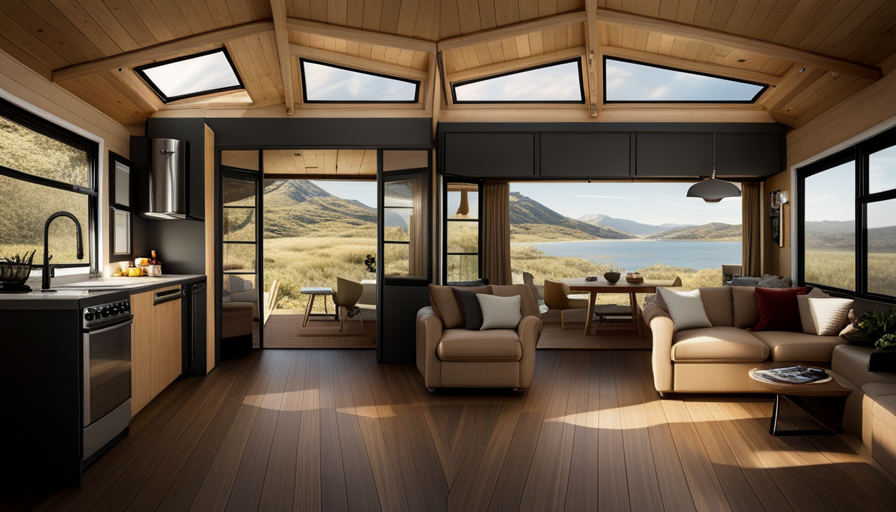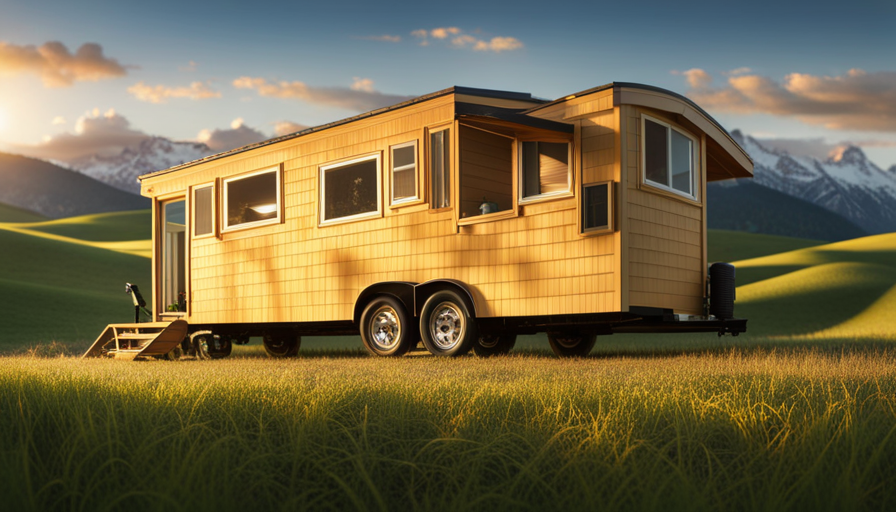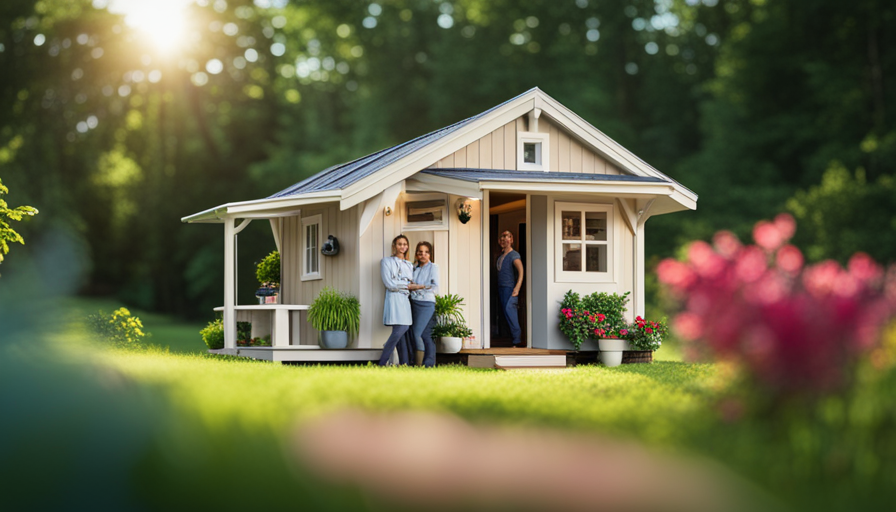Have you ever experienced the sensation of being a colossus confined within a minuscule realm? Today, my passionate tiny home aficionados, we set forth on an adventure in pursuit of unparalleled vertical liberation! Within this article, we shall delve into the realms of what is achievable regarding the ceiling height of a tiny house on wheels. Get ready to be astonished as we navigate through the complex domain of design elements, construction regulations, and the feasible constraints that determine the maximum height our compact dwellings can achieve.
But fear not, for where there are limitations, there are also creative solutions. We shall uncover the secrets of increasing vertical space and the benefits that come with it. And let us not forget the importance of mobility and travel, for our tiny houses are not just stationary abodes.
So buckle up, my friends, as we embark on this journey to discover just how high our tiny dreams can soar!
Key Takeaways
- Maximizing interior ceiling height in tiny houses on wheels requires strategic placement of load-bearing walls and the use of lightweight materials.
- Incorporating tall windows and skylights can help create a sense of spaciousness and increase vertical space in the interior.
- Building codes and regulations, as well as practical limitations such as weight distribution and road clearance, need to be considered when determining the height of interior ceilings.
- Achieving stability and balance during transportation of a tiny house on wheels involves proper weight distribution, securing loose objects, and considering clearance height when passing under bridges and overpasses.
Design Considerations for Maximizing Ceiling Height
When it comes to designing a tiny house on wheels, one important consideration is how to maximize the height of the interior ceilings. Design aesthetics play a crucial role in creating a visually appealing space, but it’s equally important to prioritize structural integrity. Balancing these factors can help create a tiny house with high ceilings that feels spacious and comfortable.
To maximize ceiling height, it’s important to carefully plan the layout and placement of walls and support structures. By strategically positioning load-bearing walls and supports, you can minimize their impact on the overall height of the interior space. Additionally, using lightweight and strong materials for the structural components can help maintain the integrity of the house while allowing for taller ceilings.
Designing with tall windows and skylights can also create the illusion of higher ceilings by allowing natural light to flood the space. This not only enhances the overall aesthetics but also makes the interior feel more open and airy.
Considering building codes and regulations is an essential step in the design process. By understanding and following these guidelines, you can ensure that your tiny house on wheels meets all necessary safety standards.
Building Codes and Regulations
If you want to maximize the vertical space in your mobile abode, it’s crucial to adhere to building codes and regulations. These codes and regulations are in place to ensure the safety and structural integrity of your tiny house on wheels.
When it comes to building codes, one important aspect to consider is the maximum height allowed for the interior ceilings. This can vary depending on the jurisdiction you are in, but generally, the maximum height for habitable spaces is around 8 feet. However, there are ways to work around this limitation and create the illusion of a higher ceiling.
The choice of building materials can play a significant role in achieving this. Opting for lightweight materials such as gypsum board or plywood can help reduce the thickness of the ceiling, thereby increasing the height of the living space. Additionally, utilizing techniques like raised platforms or lofts can create additional headroom in certain areas.
By understanding and following the building codes and regulations, you can ensure that your tiny house on wheels meets the necessary requirements for a safe and comfortable living space.
Moving forward, let’s discuss the practical limitations of ceiling height without compromising on structural integrity.
Practical Limitations of Ceiling Height
Maximizing vertical space in your mobile abode demands careful consideration of practical limitations in order to create a living space that feels open and unrestricted. When it comes to the interior ceilings of a tiny house on wheels, there are design options and structural constraints that need to be taken into account.
Here are five factors to consider when determining the practical limitations of ceiling height:
-
Weight distribution: The weight of the ceiling materials and any additional features such as lighting fixtures or ventilation systems can impact the overall weight distribution of the tiny house. This can affect the stability and maneuverability of the structure.
-
Road clearance: The height of the tiny house, including the interior ceiling, must comply with road clearance regulations to ensure safe transportation.
-
Structural integrity: The size and weight of the tiny house can impose limitations on the height of the interior ceiling. The structural components need to be able to support the weight without compromising the integrity of the overall structure.
-
Door and window placement: The height of the interior ceiling may be limited by the placement of doors and windows. These openings need to be properly integrated into the design to ensure functionality and aesthetics.
-
Overall dimensions: The size of the tiny house on wheels, including the width and length, can influence the height of the interior ceiling. It is important to consider the dimensions of the entire structure to achieve a harmonious design.
Considering these design options and structural constraints will help you determine the practical limitations of ceiling height in a tiny house on wheels. With an understanding of these factors, you can explore creative solutions for increasing vertical space without compromising safety or functionality.
Creative Solutions for Increasing Vertical Space
To optimize the vertical space in your compact mobile dwelling, consider clever techniques to create captivating and cozy living quarters. Space-saving solutions are essential in a tiny house on wheels, and one popular design choice is incorporating a loft.
By utilizing the height of the structure, you can create additional living space without sacrificing the overall footprint of your tiny home.
When designing a loft, it’s important to take into account the height limitations of your tiny house. The ceiling height in the loft area will typically be lower than in the main living space, so it’s crucial to plan accordingly.
One option is to have a raised platform with a lower ceiling height underneath, allowing for a comfortable sleeping space above and a cozy seating area below. Another creative solution is to install a retractable bed that can be raised and lowered as needed, maximizing the vertical space during the day.
By incorporating these space-saving solutions and a well-thought-out loft design, you can make the most of the limited vertical space in your tiny house on wheels. This will not only provide you with a functional and comfortable living area but also allow for a sense of openness and expansiveness.
In the following section, we will explore the benefits of higher ceilings in a tiny house on wheels, highlighting the advantages they bring to the overall design and living experience.
Benefits of Higher Ceilings in a Tiny House on Wheels
Incorporating lofty ceilings in a compact mobile dwelling can enhance the spatial experience and create an atmosphere of openness and expansiveness. When it comes to tiny houses on wheels, higher ceilings offer a range of benefits and can be achieved through various construction techniques.
-
Increased Vertical Space: Higher ceilings provide a sense of freedom and prevent the space from feeling cramped. It allows for better air circulation and natural light to flow through the interior, making the tiny house feel larger and more comfortable.
-
Enhanced Design Possibilities: With higher ceilings, you have more design options for storage solutions, such as utilizing vertical space for built-in shelves or cabinets. It also allows for creative loft designs or the incorporation of mezzanine levels, expanding the usable area within the tiny house.
-
Improved Psychological Well-being: Studies have shown that higher ceilings can positively impact our mood and mental well-being. They create a sense of spaciousness and freedom, reducing feelings of claustrophobia and promoting a more relaxed and peaceful environment.
Considering the benefits of higher ceilings, it’s important to also take into account the mobility and travel aspect of a tiny house on wheels.
Considerations for Mobility and Travel
When considering the mobility and travel aspect of a tiny house on wheels, it’s important to take into account the clearance height for bridges and overpasses. It’s crucial to ensure that the tiny house can safely fit under these structures without causing any damage.
Additionally, maintaining stability and balance during transportation is essential to prevent any accidents or mishaps on the road. This involves careful weight distribution and securing the house properly to the trailer.
Lastly, securing loose objects inside the tiny house is crucial for safe travel, as any unsecured items can become dangerous projectiles during transportation.
Clearance Height for Bridges and Overpasses
Imagine cruising down the road in your tiny house on wheels, feeling like a giant in a world of bridges and overpasses that just can’t handle your lofty interior ceilings. When it comes to clearance height for bridges and overpasses, there are a few things to consider.
-
Bridge height restrictions: It’s crucial to be aware of the maximum height allowed for vehicles passing under bridges. This includes not only the height of the tiny house itself but also any additional height added by roof-mounted features such as solar panels or air conditioning units.
-
Impact of roof design: The shape and slope of the roof can affect the overall height of the tiny house. A flatter roof design may allow for slightly more clearance than a peaked roof.
-
Roof materials: Using lightweight materials for the roof can help minimize the overall height of the tiny house, providing more flexibility when it comes to passing under bridges and overpasses.
Considering these factors, it’s important to carefully plan the height of the interior ceilings in a tiny house on wheels to ensure they comply with bridge height restrictions and maintain stability and balance during transportation.
Maintaining Stability and Balance During Transportation
To ensure a smooth and safe journey, you’ll want to pay close attention to maintaining stability and balance while transporting your mobile abode. This is crucial in preventing structural damage and ensuring the longevity of your tiny house on wheels.
One of the key aspects to consider is weight distribution strategies. Properly distributing the weight inside the tiny house is essential to maintaining balance and stability during transportation. Placing heavier items closer to the center of the trailer and securing them tightly will help prevent any shifting or swaying that could lead to instability.
Additionally, using stabilizer jacks and wheel chocks can provide extra support and stability. By implementing these weight distribution strategies, you can minimize the risk of damage and ensure a safe journey for your tiny house on wheels.
Transitioning into the subsequent section, it’s also important to secure loose objects for safe travel without compromising stability.
Securing Loose Objects for Safe Travel
When it comes to maintaining stability and balance during transportation, securing loose objects is crucial.
Now, let’s delve into the current subtopic of cargo organization and weight distribution. In a tiny house on wheels, maximizing space is essential, but it shouldn’t compromise safety. To ensure a smooth journey, it’s important to strategically secure and organize your belongings.
Proper cargo organization involves arranging items in a way that distributes weight evenly throughout the tiny house. This helps maintain balance and stability, preventing any potential accidents or damage.
Additionally, securing loose objects prevents them from shifting or falling during travel, which could disrupt the weight distribution and compromise the overall stability of the tiny house.
A well-organized and securely loaded interior won’t only enhance the safety of your journey but also provide peace of mind knowing that everything is in its rightful place.
Frequently Asked Questions
What are the average ceiling heights in a typical tiny house on wheels?
On average, the ceiling heights in a typical tiny house on wheels range from 6.5 to 8 feet. However, higher ceilings have their own advantages. They create an illusion of more space, making the interior feel less cramped. Additionally, taller individuals will appreciate the extra headroom. It’s important to consider the overall design and weight limitations of a tiny house on wheels when determining the optimal ceiling height.
Can the interior ceilings of a tiny house on wheels be raised or modified after construction?
Yes, the interior ceilings of a tiny house on wheels can be raised or modified after construction. By raising the ceiling height, you can create a more spacious and open atmosphere. However, it’s important to consider the structural integrity of the house and the weight distribution when making such modifications. It may require reinforcing the walls and roof to ensure stability. Consulting a professional builder or engineer is recommended to ensure the modifications are done safely and effectively.
Are there any safety concerns or risks associated with higher ceilings in a tiny house on wheels?
Safety concerns and structural risks are important factors to consider when discussing higher ceilings in a tiny house on wheels. One anecdote that comes to mind is the story of a friend who decided to raise the ceilings in their tiny house. They didn’t take into account the weight distribution and stability of the structure. As a result, the house became top-heavy and had an increased risk of tipping over.
This emphasizes the need for careful planning and consultation with experts to ensure the safety and stability of any modifications to a tiny house on wheels.
How does the height of the trailer affect the maximum ceiling height of a tiny house on wheels?
The height of the trailer has a significant impact on the maximum ceiling height of a tiny house on wheels. Trailer height limitations determine the overall height of the house, including the interior ceilings. If the trailer is too tall, it can result in clearance issues, making the house unable to pass under bridges or through tunnels.
Therefore, it’s crucial to consider the trailer’s height when determining the maximum ceiling height for a tiny house on wheels.
Are there any specific design or construction techniques that can help maximize ceiling height in a tiny house on wheels?
Looking to maximize the ceiling height in your tiny house on wheels? Well, let me ask you this: Have you considered design techniques and construction methods?
By carefully planning the layout and using innovative design strategies, you can create a spacious and airy interior. Utilizing techniques such as raised flooring, vaulted ceilings, and skylights can make a significant difference in the perceived height of the space.
Additionally, using lightweight materials in the construction can help maximize headroom without compromising structural integrity.
Conclusion
In conclusion, the height of the interior ceilings in a tiny house on wheels is crucial for maximizing space and creating an open, airy atmosphere. However, building codes and practical limitations must be considered when determining the maximum height.
By employing creative solutions and innovative design techniques, it’s possible to increase vertical space and achieve higher ceilings. The benefits of higher ceilings include a sense of spaciousness, improved ventilation, and the ability to incorporate loft areas.
It’s important to balance these considerations with the practicality of mobility and travel.
Hi, I’m Emma. I’m the Editor in Chief of Tiny House 43, a blog all about tiny houses. While tree houses are often associated with childhood, they can be the perfect adult retreat. They offer a cozy space to relax and unwind, surrounded by nature. And since they’re typically built on stilts or raised platforms, they offer stunning views that traditional homes simply can’t match. If you’re looking for a unique and romantic getaway, a tree house tiny house might just be the perfect option.










